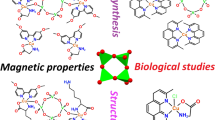Abstract
Reactions of the macrocyclic ligand [L·2HClO4] with the reactants [Ir(CO)(Ph3P)2Cl] and [RuCl3(AsPh3)2CH3OH], produces bimetallic complexes with the stoichiometries [Ir2L(Ph3P)2Cl(ClO4)] (I) and [Ru2LCl4(ClO4)2] (II), respectively. Physico-chemical and spectroscopic data of the complexes confirms the encapsulation of two metal ions in the macrocyclic cavities via coordination through nitrogen atoms of the unsymmetrical aza groups, which results in homo-dinuclear macrocyclic complexes. The macrocyclic ligand has accommodated both the lower, Ir(I), and higher, Ru(III), oxidation states of metal ions, which shows the flexible nature and capability of macrocycle to form stable complexes. The mode of bonding and geometry of the complexes have been established on the basis of FT-IR, NMR, ligand field spectral, magnetic susceptibility and conductivity measurements. The thermodynamic first ionic association constants (K1), corresponding free energy change (ΔG) and other related parameters from conductometric studies using the Fuoss and Edelson method of complexes in DMSO have been determined and discussed.



Similar content being viewed by others
References
Bencini, A., Bianchi, A., Dapporto, B., Gracia-Espana, E., Micheloni, M., Paoletti, P. Paoli, P.: Di- and tri-palladium(ii) polyazacycloalkane complexes. A case of deprotonated secondary nitrogen in solution and in solid state. J. Chem. Soc. Chem. Commun. 19, l382–1384 (1990)
Okawa, H., Nishio. J., Ohba, M., Tadokoro, M., Matsumoto, N., Koikawa, M., Kida, S., Fenton, D.E.: Heterodinuclear CuIIPbII and CuIIMII (M = Mn, Fe, Co, Ni, Cu, Zn) complexes of macrocycles with dissimilar 4- and 5-coordination sites: synthesis, structures, and properties. Inorg. Chem. 32, 2949–2957 (1993) and references cited therein
Babcock, G.T., Vickery, L.E., Palmer, G.: The electronic state of heme in cytochrome oxidase II. Oxidation-reduction potential interactions and heme iron spin state behavior observed in reductive titrations. J. Biol. Chem. 253, 2400–2411 (1978)
Richardson, J.S., Thomas, K.A., Rubin, B.H., Richardson, D.C.: Crystal structure of bovine cu, zn superoxide dismutase at 3 a resolution: chain tracing and metal ligands. Proc. Nat. Acad. Sci. USA 72, 1349–1353 (1975)
Zanello, P., Tamburini, S., Vigato, P.A., Mazzocchin, G.A.: Syntheses, structure and electrochemical characterization of homo- and heterodinuclear copper complexes with compartmental ligands. Coord. Chem. Rev. 77, 165–273 (1987)
Milgrom, L.R.: The Colours of Life, An Introduction to the Chemistry of Porphyrins and Related Compounds. Oxford University Press, New York (1997)
Sibert, J.W., Cory, A.H., Cory, J.G.: Lipophilic derivatives of cyclam as new inhibitors of tumor cell growth. Chem. Commun. 154–155 (2002)
Caravan, P., Ellison, J.J., McMurry, T.J., Lauffer, R.B.: Gadolinium (III) chelates as MRI contrast agents structures, dynamics and applications. Chem. Rev. 99, 2293–2352 (1999)
Garcia, V.P., Yazigi, D.V., Cabrera, A., Galvez, P.V., Arriagada, M., Leon, D.R., Pizarro, N., Zanocco, A., Spodine, E.: Optical properties of binuclear zinc (II) macrocyclic complexes derived from 4-methyl-2,6-diformylphenol and 1,2-diaminobenzene. Polyhedron 28, 2335–2340 (2009)
Che, C.M., Ho, C.M., Huang, J.S.: Metal–carbon multiple bonded complexes: carbene, vinylidene and allenylidene complexes of ruthenium and osmium supported by macrocyclic ligands. Coord. Chem. Rev. 251, 2145–2166 (2007)
Rani, S., Kumar, S., Chandra, S.: Synthesis, structural, spectral, thermal and anti- microbial studies of palladium(II), platinum(II), ruthenium(III) and iridium(III) complexes derived from N, N, N, N-tetradentate macrocyclic ligand, Spectrochim. Acta Part A 78, 1507–1514 (2011)
Mewis, R.E., Archibald, S.J.: Biomedical applications of macrocyclic ligand complexes. Coord. Chem. Rev. 254, 1686–1712 (2010)
Khan, M.M.: Ru(III), Pd(II), Pt(III), and Pt(IV) Complexes of a novel 32-membered unsymmetrical dinucleating macrocyclic ligand. synth. react. Inorg. Met.-Org. Chem. Nano-Met. Chem. 40, 148–152 (2010)
Siddiqi, Z.A., Khan, M.M., Khalid, M., Kumar, S.: Spectral and electrochemical characterization of bimetallic complexes of a novel 32-membered unsymmetrical [N12] macrocycle. Transition Met. Chem. 32, 927–935 (2007)
Siddiqi, Z.A., Khan, M.M.: Synthesis and characterization of a novel 32.membered unsymmetrical dinucleating [N12] macrocycle: preparation of bimetallic complexes M2LX2(ClO4)2 (M=Zn, Cd, or Hg; X=Cl, NCS, or NO3). Synth. React. Inorg. Met.-Org. Chem. Nano-Met. Chem 34, 897–917 (2004)
Siddiqi, Z.A., Khan, M.M., Khalid, M.: Synthesis and spectral studies of a novel 20-membered unsymmetrical dinucleating [N8] macrocycle and its bimetallic complexes, M2LCln(ClO4)2 (n = 2, M=Co, Ni or Cu; N = 4, M=Cr or Fe). Polish J. Chem. 80, 377–386 (2006)
Stephenson, T.A., Wilkinson, G.: New complexes of ruthenium (II) and (III) with triphenylphosphine, triphenylarsine, trichlorostannate, pyridine, and other ligands. J. Inorg. Nucl. Chem. 28, 945–956 (1966)
Furniess, B.S.: Vogel’s Text Book of Practical Organic Chemistry, V Edn. (1989)
Jolly, W.L.: The Synthesis and Characterization of Inorganic Compounds, Printice-Hall Inc. U.K. and Eire Printice Hall of Canada, Canada (1970)
Nakamoto, K.: Coordination compounds; organometallic compounds. In Infrared and Raman Spectra of Inorganic and Coordination Compounds, pp. 191–403, 4th Edn., A Wiley-Interscience Publication (1986)
Rosenthal, M.R.: The myth of the non-coordinating anion. J. Chem. Soc. 50, 331–334 (1973)
Lever, A.B.P.: Charge transfer spectra. In Inorganic Electronic Spectroscopy, pp. 125–248, 2nd Edn., Elsevier, Amsterdam (1984)
Lewis, J., Wilkins, R.G.: Modern Coordination Chemistry. Interscience Publisher, New York (1960)
Fuoss, R.M., Edelson, D.: Bolaform electrolytes. I. Di-(β-trimethylammoniumethyl)-succinate dibromide and related compounds. J. Am. Chem. Soc. 73, 269–273 (1951)
Onsagar, L.: Zur Theorie der electrolyte II. Physik Z 28, 277–298 (1927)
Bozic, L.T., Bozic, B.: Conductance study of ion-pairing of potassium monoethyl benzeneazophosphonates and their macrocyclic polyether complexes in acetonitrile. Electrochim. Acta 35, 59–61 (1990)
Acknowledgments
Author is thankful to Prof. Z. A. Siddiqi, Department of Chemistry, Aligarh Muslim University, Aligarh, India, for fruitful discussion.
Author information
Authors and Affiliations
Corresponding author
Rights and permissions
About this article
Cite this article
Khan, M.M. Spectroscopic and physico-chemical characterization of Ir(I) and Ru(III) complexes of 32-membered unsymmetrical dinucleating macrocyclic ligand. J Incl Phenom Macrocycl Chem 78, 257–263 (2014). https://doi.org/10.1007/s10847-013-0294-1
Received:
Accepted:
Published:
Issue Date:
DOI: https://doi.org/10.1007/s10847-013-0294-1




